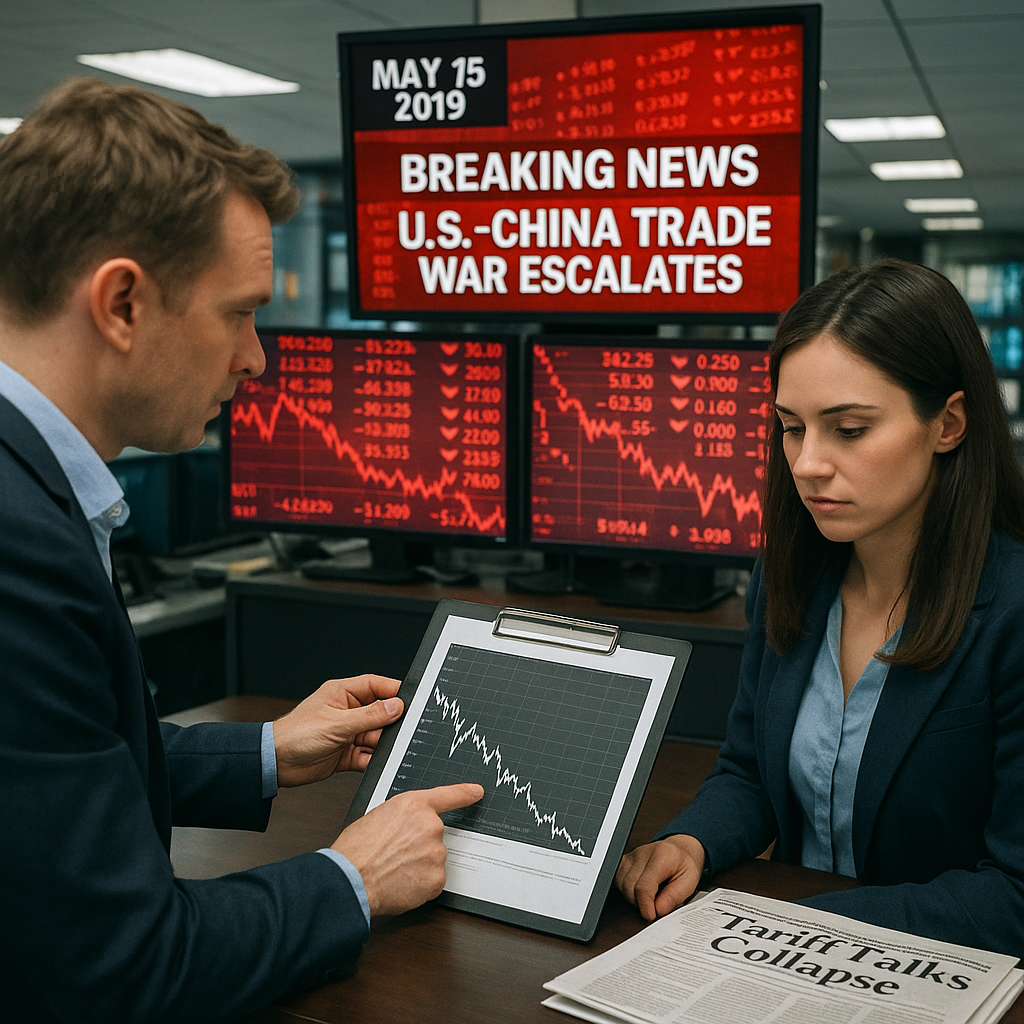U.S.-China Trade War Tensions Shake Global Markets
In May 2019, tensions between the United States and China escalated dramatically, sending shockwaves through global financial markets. After months of trade negotiations that appeared to be making progress, President Donald Trump announced a sharp increase in tariffs on Chinese goods — reigniting fears of a prolonged U.S.-China trade war.
Equity markets across the globe responded swiftly. The S&P 500 fell over 5% during the first two weeks of May, while emerging market indices tumbled even further. Investors fled to safe haven assets like gold and U.S. Treasuries, as volatility surged and uncertainty returned to the forefront.
What Triggered the Escalation?
The situation escalated after a surprise move by the U.S. administration:
-
On May 5, 2019, President Trump tweeted that tariffs on $200 billion in Chinese imports would rise from 10% to 25%, citing China’s backtracking on key parts of the draft trade agreement.
-
The new tariff rate took effect on May 10.
-
China responded on May 13 with retaliatory tariffs on $60 billion in U.S. goods, effective June 1.
This tit-for-tat escalation renewed concerns about a breakdown in diplomatic relations and the potential for long-term damage to the global economy.
Impact on Global Markets
The renewed trade war immediately shook investor confidence, causing ripple effects in nearly every asset class:
1. Stock Market Declines
-
Dow Jones Industrial Average and S&P 500 posted their worst weekly losses of 2019.
-
Technology stocks were especially hit, with Apple and chipmakers like NVIDIA and Qualcomm falling sharply due to their supply chain exposure to China.
-
Chinese indices, including the Shanghai Composite, also fell over 6% in response.
2. Currency Volatility
-
The Chinese yuan weakened past the psychologically important 6.90 level against the U.S. dollar.
-
The Japanese yen and Swiss franc — traditional safe havens — saw sharp inflows.
3. Bond Yields Fell
-
The 10-year U.S. Treasury yield declined below 2.4%, signaling a flight to safety.
-
Yield curve flattening resumed, with concerns of slowing growth and possible recession increasing again.
4. Commodities Reacted
-
Oil prices dropped on fears of reduced global demand.
-
Gold rose as investors hedged against geopolitical risk.
Investor Sentiment Turns Defensive
Prior to May, markets had largely priced in a positive resolution to the U.S.-China trade dispute. The sudden reversal forced investors to reassess their portfolios and economic forecasts.
Shifts observed:
-
Increased allocation to defensive sectors like utilities and healthcare.
-
Rebalancing toward cash and short-duration bonds.
-
Hedge funds ramping up volatility trades and reducing exposure to Chinese equities.
Some institutional strategists even raised the possibility of a “full decoupling” between the U.S. and Chinese economies, which would require massive supply chain restructuring.
Wider Economic Implications
The trade war’s effects go beyond stock tickers and bond yields. Economists warned of significant macroeconomic fallout if the tensions persist.
1. Slower Global Growth
The IMF had already downgraded its global growth forecast for 2019 to 3.3% in April. The May escalation may force a further revision downward, especially for export-reliant economies like Germany, South Korea, and Japan.
2. Business Uncertainty
Global corporations, especially in manufacturing, tech, and logistics, now face renewed uncertainty regarding tariffs, regulations, and market access — factors that can delay investment decisions and hiring.
3. Supply Chain Risks
Companies such as Apple, Caterpillar, and Boeing are assessing how a prolonged dispute may affect production, pricing, and demand across markets.
Crypto and Gold Gain Traction
Interestingly, the trade war uncertainty also had indirect effects on alternative assets:
-
Bitcoin rose from ~$5,200 to over $7,000 during May, with some analysts suggesting investors in China and elsewhere were seeking non-sovereign stores of value.
-
Gold rallied above $1,300/oz, its highest level in months.
While it’s too early to claim crypto is a safe haven on par with gold, the correlation during this period fueled debate about Bitcoin’s evolving role in macroeconomic events.
What to Watch Going Forward
With talks between Washington and Beijing ongoing but increasingly volatile, investors and analysts are closely monitoring:
-
Tariff timelines and possible rollbacks or expansions
-
Federal Reserve response, particularly if trade tensions slow growth further
-
Corporate earnings guidance, especially from companies with global exposure
-
Consumer confidence and spending as potential leading indicators of economic softness
-
Signals from Chinese authorities, such as currency or monetary policy interventions
The path forward is highly uncertain, and market sentiment may continue to swing rapidly with every new headline or tweet.
Conclusion
The U.S.-China trade war tensions in May 2019 serve as a stark reminder that geopolitical risks remain one of the most unpredictable and impactful forces in global finance. Markets had priced in optimism — and were swiftly reminded that negotiations can fail.
While the long-term implications remain unknown, the short-term volatility is undeniable. For investors, the moment calls for discipline, diversification, and a keen eye on both fundamentals and global headlines.
